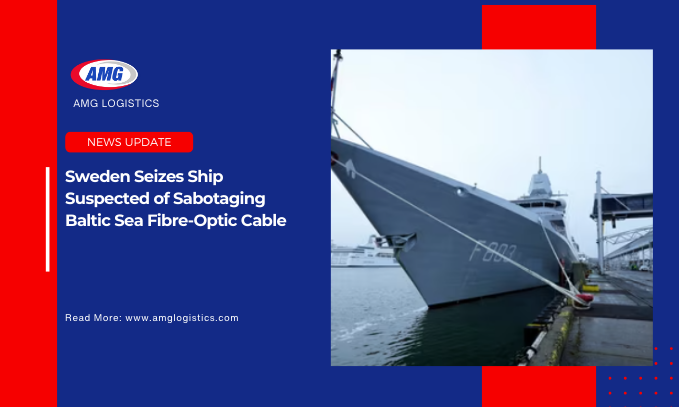On Sunday, Sweden seized a vessel suspected of damaging a fibre-optic cable beneath the Baltic Sea, which connects Sweden to Latvia. This incident is the latest in a series of suspected attacks targeting undersea cables in the region, raising concerns over the security of Europe’s critical infrastructure. Sweden’s prosecutors have launched an investigation into the matter, labeling it as aggravated sabotage.
The Incident and Investigation
Sweden’s prosecutors confirmed that they had seized a ship suspected of causing the damage to the undersea data cable. The damage, which occurred within Swedish territorial waters, was detected at a depth of at least 50 meters (about 164 feet). The cable, owned by Latvia’s state radio and television center (LVRTC), is vital for data transmission between the two countries. While data transmission disruptions were reported, the company assured that alternative channels were in place, though there might be delays in service.
Latvia’s navy had identified the suspect vessel, named Michalis San, near the incident location. Additionally, two other ships were reported in the area. Some sources tracking naval traffic indicated that the Michalis San was headed towards Russia, intensifying suspicions regarding possible Russian involvement in the sabotage.
Escalating Concerns Over Baltic Sea Sabotage
The Baltic Sea has recently become a focal point for geopolitical tensions, with increasing incidents of damage to vital undersea infrastructure. Experts and political figures are increasingly attributing these acts of sabotage to Russia as part of a larger hybrid warfare campaign against Western nations.
Ukraine’s Foreign Minister, Andriy Sybiga, expressed concern over the growing pattern of attacks on critical EU infrastructure, stressing the need for an increased NATO presence in the region to safeguard against further threats.
“The damage to the Sweden-Latvia undersea cable is just the latest in a series of targeted incidents,” Sybiga stated on X (formerly Twitter). “It is vital that NATO enhances its monitoring efforts to protect this infrastructure.”
International Response and Cooperation
In response to the incident, Sweden and Latvia have coordinated their efforts to investigate the damage. Swedish Prime Minister Ulf Kristersson confirmed that both countries were working closely together, with NATO also involved in monitoring the situation.
“At least one data cable between Sweden and Latvia has been damaged, and we are closely cooperating with Latvia and NATO on this issue,” Kristersson wrote on X. This collaboration underscores the importance of securing Europe’s critical infrastructure and ensuring that such incidents do not escalate.
Impact on EU Infrastructure and Security
The damage to the undersea cable highlights growing vulnerabilities in Europe’s critical infrastructure, which relies heavily on undersea cables for data transmission. These cables, which connect countries across the continent, are crucial for communication, business, and military operations.
As European nations grapple with the security of their undersea infrastructure, NATO recently announced a new monitoring mission in the Baltic Sea to prevent further sabotage. This mission will include patrol ships and aircraft tasked with deterring attacks on vital undersea assets.
Conclusion: Strengthening Security in the Baltic Sea
The recent sabotage of the Sweden-Latvia undersea data cable is a stark reminder of the growing threat to critical infrastructure in the Baltic Sea. As countries in the region, including Sweden, Latvia, and NATO, continue to strengthen their defense measures, ensuring the resilience and security of these vital connections will be paramount in preventing future disruptions.
With increasing international attention on these incidents, the focus will now shift toward securing undersea cables and enhancing cooperation between nations to protect Europe’s digital infrastructure from further sabotage.





